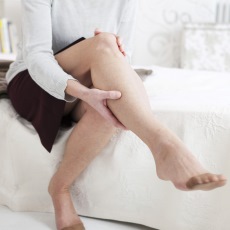
Deep Vein Thrombosis
Also called: DVT
National Institutes of Health
Other Languages
Deep vein thrombosis, or DVT, is a blood clot that forms in a vein deep in the body. Most deep vein clots occur in the lower leg or thigh. If the vein swells, the condition is called thrombophlebitis. A deep vein thrombosis can break loose and cause a serious problem in the lung, called a pulmonary embolism.
Sitting still for a long time can make you more likely to get a DVT. Some medicines and disorders that increase your risk for blood clots can also lead to DVTs. Common symptoms are
- Warmth and tenderness over the vein
- Pain or swelling in the part of the body affected
- Skin redness
Treatment includes medicines to ease pain and inflammation, break up clots and keep new clots from forming. Keeping the affected area raised and applying moist heat can also help. If you are taking a long car or plane trip, take a break, walk or stretch your legs and drink plenty of liquids.
- D-dimer Test (American Association for Clinical Chemistry)
- Doppler Ultrasound
 (National Library of Medicine)Also in Spanish
(National Library of Medicine)Also in Spanish - Venography (American College of Radiology, Radiological Society of North America)Also in Spanish
- Venous Ultrasound (Extremities) (American College of Radiology, Radiological Society of North America)Also in Spanish
- How to Spot and Prevent Deep Vein Thrombosis
 (National Institutes of Health)Also in Spanish
(National Institutes of Health)Also in Spanish - Preventing Deep Vein Thrombosis (American College of Obstetricians and Gynecologists)Also in Spanish
- Blood Thinners: MedlinePlus Health Topic
 (National Library of Medicine)Also in Spanish
(National Library of Medicine)Also in Spanish - Catheter-Directed Thrombolysis (Radiological Society of North America)Also in Spanish
- Inferior Vena Cava Filter Placement and Removal (American College of Radiology, Radiological Society of North America)Also in Spanish
- Deep Vein Thrombosis and Post-Thrombotic Syndrome What you Need to Know About Compression Therapy for DVT and PTS (Vascular Disease Foundation) - PDF
- Patient's Guide to Recovery After Deep Vein Thrombosis or Pulmonary Embolism (American Heart Association)
- Blood Clots and Travel: What You Need to Know (Centers for Disease Control and Prevention)Also in Spanish
- Heparin-Induced Thrombocytopenia (American Heart Association) - PDF
- Postthrombotic Syndrome (American Heart Association)
- Travelers' Health: Deep Vein Thrombosis and Pulmonary Embolism (Centers for Disease Control and Prevention)
- Venous Thromboembolism and Marathon Athletes (American Heart Association) - PDF
- What is Chronic Venous Insufficiency (CVI)? (Vascular Disease Foundation) - PDF
- Deep Vein Thrombosis (Vascular Disease Foundation) - PDF
- Venous Thromboembolism (VTE) (Vascular Disease Foundation) - PDF
- Venous thrombosis - slideshow (Medical Encyclopedia)Also in Spanish
- Preventing Blood Clots After Orthopaedic Surgery
 (American Academy of Orthopaedic Surgeons)
(American Academy of Orthopaedic Surgeons)
- Data and Statistics of DVT/PE (Centers for Disease Control and Prevention)
- ClinicalTrials.gov: Phlebitis
 (National Institutes of Health)
(National Institutes of Health) - ClinicalTrials.gov: Thrombophlebitis
 (National Institutes of Health)
(National Institutes of Health) - ClinicalTrials.gov: Venous Thrombosis
 (National Institutes of Health)
(National Institutes of Health)
- Glossary (Vascular Cures)
- Vasculature of the Leg (Texas Heart Institute)Also in Spanish
- Blood Clotting and Pregnancy
 (American Society of Hematology)
(American Society of Hematology)
- Compression stockings (Medical Encyclopedia)Also in Spanish
- D-dimer test (Medical Encyclopedia)Also in Spanish
- Deep vein thrombosis - discharge (Medical Encyclopedia)Also in Spanish
- Deep venous thrombosis (Medical Encyclopedia)Also in Spanish






















.png)











No hay comentarios:
Publicar un comentario